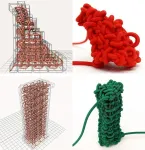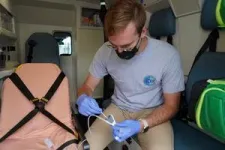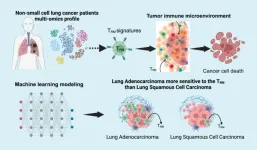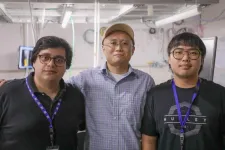(Press-News.org) Yuichi Hirose has a dream — a dream that someday everyone will have access to a machine capable of knitting furniture.
This machine wouldn't just knit the furniture's exterior fabric, but would use knitting to fashion solid three-dimensional chairs, tables and other objects. Tired of that love seat? Just unravel it and reuse the yarn to knit yourself an ottoman.
This new fabrication technique — first envisioned by Hirose, a robotics Ph.D. student in Carnegie Mellon University's School of Computer Science — is called solid knitting. The idea captured his imagination more than a decade ago. And now, working with a research team headed by James McCann, an associate professor in the Robotics Institute, he's made it a reality.
"My dream is to have these solid knitting machines everywhere in the world," Hirose said.
While he was still building the machine, Hirose saw a report on the internet about a software project by McCann that made it easier to reprogram commercial knitting machines. This method provided a practical way to use the machines to make customized 3D knitted pieces. These were hollow shapes, such as bunny rabbits that could be stuffed, not solid knitted pieces, but Hirose and McCann began talking about a possible collaboration.
Hirose's knitting machine was somewhat finished by 2020, but the pandemic put the collaboration on hold. In 2022, Hirose finally joined the Textiles Lab as a research assistant and, later, joined the Ph.D. program in robotics.
The CMU team presented its solid knitting research and the prototype machine at SIGGRAPH 2024, the annual Conference on Computer Graphics and Interactive Techniques, where it won an honorable mention in the Best Paper competition. SIGGRAPH posted a blog entry about the project.
The prototype, about the size of a clothes dryer, is still limited in the shapes and sizes it can produce. It can make triangular or rectangular prisms of varying lengths. The goal is to create a machine that can produce solid objects automatically, but more work is necessary to improve its operation.
The machine stretches the yarn loops quite a bit, so the researchers have used elastic cord as their yarn. Yet the resulting solid knits are "surprisingly firm," considering that they are made of floppy cord, McCann said.
"It feels sort of like a stack of felt or the sole of a shoe," he said.
Though the machine is now limited in what it can produce, it is possible to use the technique to hand-knit larger, more intricate shapes, such as a pair of sandals.
Hirose said he plans to take future research in two different directions: building a much bigger machine for producing furniture and making a smaller machine for precise objects.
"We hope that other people out there are going to build their own solid knitting machines and come up with ideas we haven't yet explored," McCann said.
In addition to Hirose and McCann, the research team included Angelica Bonilla Fominaya, an arts and computer science student now a Google software engineer, who used the technique to produce art pieces. Mark Gillespie, who recently received his Ph.D. in computer science, developed the project's 3D visualization software, which has proven a boon in understanding the complex design process.
The research was supported by Japan's Ministry of Internal Affairs and Communications, Panasonic Holdings Corp., Japan's Information-Technology Promotion Agency, and the National Science Foundation.
More information is available on the project website, particularly for other researchers.
If that all sounds a bit confusing, you're in good company. You can think of solid knitting as analogous to 3D printing. Just as 3D printers build shapes layer by layer, solid knitting builds shapes by adding knitted layer after knitted layer. But rather than being held together by glue or melted plastic, each new layer is stitched to the previous one.
It's possible to produce solid knitting by hand, rather than with a machine, to gain a deeper understanding. The researchers have released a set of hand knitting instructions and a video for knitters who'd like to know more.
"It can be hard to wrap your head around the concept," said McCann, leader of the Carnegie Mellon Textiles Lab. "But it's a very cool idea, and one that has a lot of promise."
Hirose got the idea back in 2012, while he was working on his master's degree in digital fabrication at Keio University in Japan. He was interested in reconfigurable objects, spurred in part by a project in SCS's Computer Science Department called Claytronics. That project sought to build small modular robots that self-assembled to create many different shapes.
"Those robots were very cool, but not very versatile," he said.
The modular robots generally were connected to each other by means such as magnets or friction (similar to LEGO bricks) and could be easily dislodged. Hirose was looking for something more durable, but still reconfigurable. That's when he got the idea for solid knitting.
He finished his master's and headed out into the working world, but he never gave up the solid knitting idea. Eventually, he secured some grants, quit his job and, in 2018, began building a solid knitting machine. Like commercial knitting machines, his used rows of latch needles — hooked needles with latches that can be closed or opened — to manipulate yarn and hold loops open for the next stitching row.
END
Watch ut IKEA: CMU Researchers eye knitted furniture
Robotics Institute introduces solid knitting as new fabrication technique
2024-07-30
ELSE PRESS RELEASES FROM THIS DATE:
Enjoy your work? Don’t sell yourself short. Buyers are willing to pay more for products you enjoy producing
2024-07-30
Researchers from Tilburg University, Northwestern University, and Lehigh University published a new Journal of Marketing study that examines how a seller’s enjoyment in making a product influences buyers’ willingness to pay and the price the seller charges.
The study, forthcoming in the Journal of Marketing, is titled “Production Enjoyment Asymmetrically Impacts Buyers’ Willingness to Pay and Sellers’ Willingness to Charge” and is authored ...
Recent study reveals key immune cells as critical factors in lung cancer prognosis
2024-07-30
(LOS ANGELES, July 30, 2024) – An extensive analytical study performed at the Terasaki Institute and published in Frontiers in Immunology highlights the crucial role of tissue-resident memory T cells and how they influence the immune environment of patients with non-small cell lung cancer and their overall prognosis.
Non-small cell lung cancer accounts for ~85% of lung tumors and is a leading cause of death in adults. Tissue-resident memory T cells, a specialized subset of immune cells residing in peripheral tissues, have been ...
Accuracy of diagnostic blood tests for Alzheimer’s disease varies
2024-07-30
Neurologists diagnose cognitive impairment with a clinical exam of memory and thinking skills. To determine whether Alzheimer’s disease is the cause of the cognitive impairment, evidence of the specific brain changes that characterize Alzheimer’s must be obtained, typically via a brain scan or spinal tap. Identifying people whose cognitive symptoms are due to Alzheimer’s disease is critical now that new Alzheimer’s therapies are available that could change the course of the illness.
To make diagnosis more convenient for patients, many companies have begun selling Alzheimer’s ...
Ze’ev Ronai steps down as cancer center director at Sanford Burnham Prebys
2024-07-30
Ze’ev Ronai, PhD, is stepping down as director of the National Cancer Institute-designated cancer center at Sanford Burnham Prebys, effective August 1. Cosimo Commisso, PhD, deputy director of the cancer center, will serve as interim head while a national search is conducted for a new cancer center director.
Ronai is moving to Cedars-Sinai Medical Center in Los Angeles where he will focus on translational research.
“During my 20 years at Sanford Burnham Prebys, I’ve had the honor of developing new research directions, institutionally, as well as in my lab,” said Ronai.
“As the director of the cancer ...
FSU researchers identify unique phenomenon in Kagome metal
2024-07-30
In traditional Japanese basket-weaving, the ancient “Kagome” design seen in many handcrafted creations is characterized by a symmetrical pattern of interlaced triangles with shared corners. In quantum physics, the Kagome name has been borrowed by scientists to describe a class of materials with an atomic structure closely resembling this distinctive lattice pattern.
Since the latest family of Kagome metals was discovered in 2019, physicists have been working to better understand their properties and potential applications. A new study led by Florida State University Assistant Professor of ...
Ochsner-Xavier Institute for Health Equity and Research publishes strategic plan
2024-07-30
NEW ORLEANS – The Ochsner-Xavier Institute for Health Equity and Research, or OXIHER, has published its first strategic plan, outlining strategic priorities and achievements since the institute began in 2020.
The strategic plan is available here.
A partnership between Ochsner Health and Xavier University of Louisiana, OXIHER examines health disparities at the community level while educating healthcare providers on creating and nurturing a culture of equity, and training more students for advanced careers in healthcare.
The new plan details OXIHER’s substantial progress in its first three years in addressing ...
Argonne receives U.S. Department of Energy funding for four next-generation clean-energy projects
2024-07-30
The U.S. Department of Energy’s (DOE) Argonne National Laboratory has been awarded funding from DOE’s Office of Technology Transitions for four new projects that will help with commercialization of innovative clean-energy technology for a sustainable future.
Argonne scientists will work to turn their innovative ideas into next-generation technology necessary to build cleaner, more resilient energy systems. These projects build on Argonne’s decades-long role at the forefront of the quest to decarbonize ...
Researchers develop general framework for designing quantum sensors
2024-07-30
Researchers from North Carolina State University and the Massachusetts Institute of Technology have designed a protocol for harnessing the power of quantum sensors. The protocol could give sensor designers the ability to fine-tune quantum systems to sense signals of interest, creating sensors that are vastly more sensitive than traditional sensors.
“Quantum sensing shows promise for more powerful sensing capability that can approach the fundamental limit set by the law of quantum mechanics, but the challenge lies in being able to direct ...
UBC super-black wood can improve telescopes, optical devices and consumer goods
2024-07-30
Thanks to an accidental discovery, researchers at the University of British Columbia have created a new super-black material that absorbs almost all light, opening potential applications in fine jewelry, solar cells and precision optical devices.
Professor Philip Evans and PhD student Kenny Cheng were experimenting with high-energy plasma to make wood more water-repellent. However, when they applied the technique to the cut ends of wood cells, the surfaces turned extremely black.
Measurements by Texas A&M University’s ...
Repair kit for NASA’s NICER mission heading to space station
2024-07-30
NASA will deliver a patch kit for NICER (Neutron star Interior Composition Explorer), an X-ray telescope on the International Space Station, on the agency’s Northrop Grumman 21st commercial resupply mission. Astronauts will conduct a spacewalk to complete the repair.
Located near the space station’s starboard solar array, NICER was damaged in May 2023. The mission team delivered the patch kit to NASA’s Johnson Space Center in Houston in May 2024 so it could be prepped and packed for the upcoming resupply mission.
“It’s ...
LAST 30 PRESS RELEASES:
Tracing the quick synthesis of an industrially important catalyst
New software sheds light on cancer’s hidden genetic networks
UT Health San Antonio awarded $3 million in CPRIT grants to bolster cancer research and prevention efforts in South Texas
Third symposium spotlights global challenge of new contaminants in China’s fight against pollution
From straw to soil harmony: International team reveals how biochar supercharges carbon-smart farming
Myeloma: How AI is redrawing the map of cancer care
Manhattan E. Charurat, Ph.D., MHS invested as the Homer and Martha Gudelsky Distinguished Professor in Medicine at the University of Maryland School of Medicine
Insilico Medicine’s Pharma.AI Q4 Winter Launch Recap: Revolutionizing drug discovery with cutting-edge AI innovations, accelerating the path to pharmaceutical superintelligence
Nanoplastics have diet-dependent impacts on digestive system health
Brain neuron death occurs throughout life and increases with age, a natural human protein drug may halt neuron death in Alzheimer’s disease
SPIE and CLP announce the recipients of the 2025 Advanced Photonics Young Innovator Award
Lessons from the Caldor Fire’s Christmas Valley ‘Miracle’
Ant societies rose by trading individual protection for collective power
Research reveals how ancient viral DNA shapes early embryonic development
A molecular gatekeeper that controls protein synthesis
New ‘cloaking device’ concept to shield sensitive tech from magnetic fields
Researchers show impact of mountain building and climate change on alpine biodiversity
Study models the transition from Neanderthals to modern humans in Europe
University of Phoenix College of Doctoral Studies releases white paper on AI-driven skilling to reduce burnout and restore worker autonomy
AIs fail at the game of visual “telephone”
The levers for a sustainable food system
Potential changes in US homelessness by ending federal support for housing first programs
Vulnerability of large language models to prompt injection when providing medical advice
Researchers develop new system for high-energy-density, long-life, multi-electron transfer bromine-based flow batteries
Ending federal support for housing first programs could increase U.S. homelessness by 5% in one year, new JAMA study finds
New research uncovers molecular ‘safety switch’ shielding cancers from immune attack
Bacteria resisting viral infection can still sink carbon to ocean floor
Younger biological age may increase depression risk in older women during COVID-19
Bharat Innovates 2026 National Basecamp Showcases India’s Most Promising Deep-Tech Ventures
Here’s what determines whether your income level rises or falls
[Press-News.org] Watch ut IKEA: CMU Researchers eye knitted furnitureRobotics Institute introduces solid knitting as new fabrication technique








